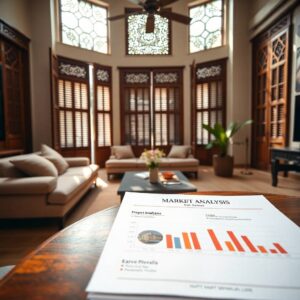 Thai Home Loans 2025 – A Market at a Crossroads
Thai Home Loans 2025 – A Market at a Crossroads
Thailand’s housing market has long been a barometer of its economic health. As we move into 2025, the sector finds itself at a critical juncture, grappling with high household debt, shifting demographics, and evolving policy interventions. This article delves into the current state of Thai home loans in 2025, the broader economic landscape, and what the future may hold for one of Southeast Asia’s most dynamic economies.
The Current State of Thai Home Loans
As of late 2024, Thailand’s household debt remains alarmingly high at 90.8% of GDP, according to the Bank of Thailand (BoT). This figure, though slightly down from its peak, continues to weigh heavily on consumer spending and borrowing capacity. The BoT’s decision to cut its benchmark interest rate to 2.25% in early 2025—down from 2.5% in late 2024—was aimed at stimulating economic growth. However, the impact on the housing market has been mixed.
Mortgage approvals have declined by 8% year-on-year (YoY) in Q1 2025, as banks tighten lending standards amid rising non-performing loans (NPLs), which now stand at 3.4% for housing loans. This cautious approach by financial institutions reflects concerns over borrower affordability and the risk of defaults in a still-fragile economy.
Shifting Demand in the Housing Market
The Thai housing market is undergoing a significant transformation, driven by demographic changes and urbanization.
- Rising Demand for Affordable Housing:
In 2025, younger buyers are increasingly gravitating toward suburban condominiums, particularly in the outskirts of Bangkok. This trend is fueled by the search for affordability, with demand in these areas surging by 15% YoY in Q1 2025. Developers are responding by launching more mid-range projects, often coupled with flexible payment plans and rent-to-own schemes. - Luxury Market Stagnation:
On the other hand, the luxury housing segment is facing headwinds. Foreign investors, who once flocked to high-end properties in Bangkok and Phuket, are now diverting their attention to emerging markets like Vietnam and Indonesia. This shift has led to a stagnation in luxury property sales, with prices remaining flat or even declining in some areas. - Aging Population and Urbanization:
Thailand’s aging population is also reshaping housing demand. Older homeowners are downsizing, while younger generations are prioritizing proximity to urban centers and public transportation. This dynamic is creating new opportunities for developers but also highlighting the need for innovative housing solutions.
Policy Interventions: Hits and Misses
The Thai government has introduced several policy measures to address the challenges in the housing market. One of the most notable is the “Housing for All 2025” initiative, which offers tax breaks and low-interest loans to first-time buyers. Early results are promising, with first-time buyer activity increasing by 12% YoY in Q1 2025.
However, critics argue that these measures are merely stopgap solutions. Without addressing deeper structural issues like wage stagnation (average wage growth stands at 2.3% YoY) and the lack of affordable housing supply, the affordability crisis is likely to persist.
Moreover, the government’s focus on stimulating demand risks inflating property prices, potentially exacerbating inequality. To achieve long-term stability, policymakers must prioritize supply-side reforms, such as streamlining land acquisition processes and incentivizing the construction of affordable housing units.
The Broader Economic Landscape
The housing market does not exist in isolation—it is deeply intertwined with Thailand’s broader economic performance.
- Tourism Rebound:
Tourism, a cornerstone of the Thai economy, has rebounded strongly, with 35 million arrivals recorded in 2024. This recovery has provided a much-needed boost to the service sector, but its benefits have been unevenly distributed. Many workers in tourism-dependent industries continue to face stagnant wages, limiting their ability to invest in housing. - Export Slowdown:
Thailand’s export sector, another key driver of economic growth, has shown signs of weakness. Export growth slowed to 1.2% YoY in Q1 2025, reflecting global economic uncertainties and shifting trade dynamics. This slowdown has dampened overall economic momentum, further complicating the housing market’s recovery. - Inflation and Monetary Policy:
Inflation remains subdued at 0.8%, well below the BoT’s target range of 1-3%. While low inflation has allowed the central bank to maintain an accommodative monetary policy, it also signals weak domestic demand. This environment poses challenges for the housing market, as consumers remain cautious about making large financial commitments.
The Role of Housing in Thailand’s Economy
The housing sector is a critical component of Thailand’s economy, contributing approximately 10% of GDP and employing millions of people. A thriving housing market can catalyze growth by stimulating construction activity, creating jobs, and boosting consumer spending. Conversely, a faltering market can have cascading effects, including layoffs in the construction sector, reduced consumption, and increased financial instability.
In 2025, the housing market’s dual role as both a driver and a reflection of economic health is more pronounced than ever. The challenge for policymakers is to strike a delicate balance between stimulating demand and addressing structural issues to ensure long-term stability.
The Path Forward: Challenges and Opportunities
As Thailand navigates the complexities of its housing market in 2025, several key challenges and opportunities emerge:
- Addressing Affordability:
Wage growth and supply-side reforms must be prioritized to make housing more accessible to middle- and lower-income families. - Encouraging Innovation:
Developers and policymakers should explore innovative solutions, such as modular housing and public-private partnerships, to increase the supply of affordable units. - Balancing Growth and Stability:
While stimulating demand is important, it must be done in a way that does not exacerbate inequality or inflate property prices. - Leveraging Technology:
Digital tools, such as online mortgage platforms and property marketplaces, can streamline processes and improve transparency, benefiting both buyers and sellers.
Conclusion
Thailand’s housing market in 2025 is a microcosm of its broader economic challenges. High household debt, shifting
As Thailand strives to balance growth and stability, the housing sector will remain a critical barometer of its economic health. By fostering innovation and prioritizing inclusive policies, the country can transform its housing market into a driver of sustainable growth—one that benefits all Thais. For those considering Thai home loans in 2025, staying informed about these trends is essential to making sound financial decisions.
Follow us on X KanHomes


 Thai Home Loans 2025 – A Market at a Crossroads
Thai Home Loans 2025 – A Market at a Crossroads


